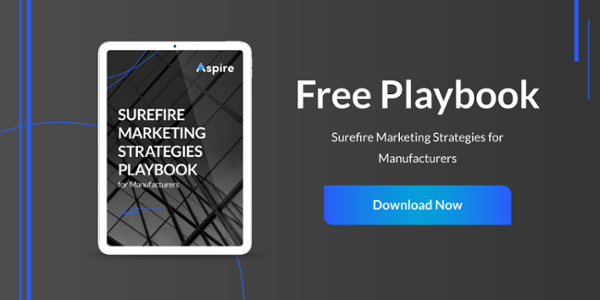- Marketing Strategy
- Manufacturing
- September 18, 2022
The 3 Marketing Strategies Every Manufacturer Needs to Grow

Aaron Marks

Odds are that your manufacturing business is approaching marketing strategy wrong.
And it’s not your fault! If you search Google for “marketing strategy ideas,” you’ll often get ideas like “post on social media,” “run LinkedIn ads,” or “create content for SEO.”
Here’s the problem: None of these are marketing strategies. They are marketing tactics.
And the #1 reason that manufacturers fail to get ROI on marketing is that they focus on tactics without a clear strategy.
Sales cycles are long for B2B manufacturers, especially those selling high-ticket and high-tech products. New business is closed over a period of months or even years, not days and weeks. And for this reason, manufacturing leaders often can’t see the results from marketing (or the lack thereof) until after they’ve made significant investments.
That’s why taking the time to build your strategy before making any major investments in marketing is crucial. You can’t afford to spend 6-12 months or more being uncertain if your marketing investment is going to pay off. (And it’s why every time we work with a new client, we start by creating a marketing plan.)
But what types of strategies are most effective for manufacturers? And what is involved in each strategy? We’ll share the three strategies every manufacturer needs to grow – but first, let’s start by explaining the difference between strategy and tactics.
What is Marketing Strategy vs. Marketing Tactics?
Many marketers and leaders alike confuse strategy and tactics. They are both different, and understanding that difference is crucial to your success.
Marketing strategy is your overall game plan or plans for how marketing is going to accomplish specific goals.
Marketing tactics are the actions you’ll take to carry out your strategy.
The best marketing strategies should flow downward from your overarching goals for the business. For example, if your business has a goal to increase sales by 10% for a specific product line, a marketing strategy might be to “Generate new demand through Inbound Marketing.” The supporting tactics for this strategy might include things like publishing two new white papers, writing a dozen blog posts, improving SEO for some specific keywords, and sending marketing emails to your list.
With these definitions out of the way, let’s turn to looking at three must-have marketing strategies for every B2B manufacturer.
B2B Manufacturing Marketing Strategy 1: Stay in front of your customers with Outbound Marketing.
If you’re like many manufacturers, this is the one area of marketing you’re already likely investing into the most. And that’s why I’ve chosen to start with it.
Outbound marketing is the traditional method of marketing, involving your company pushing messaging out to potential customers. Outbound marketing includes things like trade shows, cold calling, buying email lists, direct mail, and most types of advertising. You might also think of it as interruption marketing: you are interrupting someone’s flow of activity in order to get their attention.
Outbound marketing can be effective. The problem is that the modern buyer of manufactured B2B products has gotten adept at avoiding many of these things. Caller ID, spam filters, and ad blockers have all come to fruition for just this reason.
There are further downsides to outbound marketing. Customer acquisition costs tend to be higher with outbound. And, it’s powered by budget and repetition: in other words, if you take a break from spending on trade shows or ads, your marketing is no longer being seen by your prospects.
Every manufacturer should have outbound marketing among the strategies it uses to acquire new customers and close new business. But it should only be one of the weapons in your manufacturing business’ strategic arsenal.
B2B Manufacturing Marketing Strategy 2: Attract, convert, close, and delight prospects with Inbound Marketing.
While outbound marketing focuses on interrupting to get someone’s attention, inbound focuses on earning that attention. The goal of inbound is to be helpful at every step of your buyer’s research process. That means offering the right content, website experiences, communications (like calls and emails), and more – at the right time, when your prospects want and need it.
And while many B2B manufacturers are doing outbound, very few are doing inbound (and even fewer are doing it well). Which is a huge mistake. The modern B2B buyer demands inbound marketing – and will take their business elsewhere without it!
That’s because the modern buyer does 67% of their research and buying process themselves online – without talking to sales. If you don’t have a great web presence and all of the things your buyer needs to do this research, they’ll turn to your competitors (and likely, your competitors will win the business).
Plus, inbound marketing is momentum-based, offering a “snowball effect” as you do more and more of it. For these reasons, inbound tends to have a much lower customer acquisition cost than outbound.
One manufacturer I worked with accelerated their sales process by 20% and more than doubled lead generation by adding an inbound marketing strategy to our existing outbound marketing efforts. We began by identifying our top three buyer personas, and then we created a content map. We then conducted a gap analysis – and found that nearly all of our content was at the bottom of the funnel (e.g., brochures and catalogs).
Our strategy for the next six months, then, was to create content to fill in the gaps in our funnel. We ramped up blog content production, created an eBook and a new white paper among other assets, and began actively promoting to our customers.
B2B Manufacturing Marketing Strategy 3: Accelerate sales and close more deals with key target accounts using Account-Based Marketing.
Your outbound and inbound marketing strategies are like throwing a big net into the ocean. You’ll catch a lot of fish, but many will be small fish, and others will be fish you’re not interested in. And that’s where Account Based Marketing (ABM) comes into play.
ABM focuses on catching specific, high-value fish, rather than a whole bunch of fish. And for manufacturers of high-ticket products, this is invaluable. Small-to-midsized companies are great customers, but putting in the energy to successfully acquire a single “whale” can be a literal goldmine for your company.
ABM starts with identifying, classifying, and prioritizing a list of Target Accounts you want to reach. For example, if you’re manufacturing a disruptive renewable product, you might want to identify and target the top 20 largest utilities in the United States.
From there, you identify the key buyers that you want to reach within these Target Accounts. So at these renewables, you might target Engineers, Purchasing, Maintenance Leaders, and Executive Leaders. Each of these has a different role on the buying committee that would choose your product.
Then, you would identify a set of tactics to help increase your exposure with these key buyers at your Target Accounts. Just like with your inbound and outbound, things like advertising, content, and email can all play a role here. But you might consider other tactics as well, like gifting – sending personalized and unique gifts, or creating personalized web pages and content.
ABM can support many different sales and marketing objectives. For example, if you’re new to the market, you might just want to increase the chances that your target buyers take a phone call with your sales team. Or if you already have decent market awareness, your goal might be to accelerate the sales pipeline or turn more open deals into closed ones.
Adopt These 3 Marketing Strategies to Grow Your Manufacturing Company
If your manufacturing business is focusing on only one or two of these strategic pillars, it means you’re falling behind the competition and your customer’s expectations. That one-two punch can quickly turn into shrinking sales and a diminishing bottom line.
Today, the most successful companies are adopting all three of these strategies to maximize their growth. By having a strategy for outbound, inbound, and account-based marketing, you can get your product to market faster, increase sales, and reach everyone from small businesses to enterprise companies who can place those coveted large orders.
Even if you’re a smaller manufacturer or startup, you can ensure your business has a foundational approach to each of these strategies by hiring a marketing agency with proven chops using them to drive ROI for manufacturers.
- Intro
- What is Marketing Strategy vs. Marketing Tactics?
- 1. Stay in front of your customers with Outbound Marketing
- 2. Attract, convert, close, and delight prospects with Inbound Marketing
- 3. Accelerate sales and close more deals with key target accounts using Account-Based Marketing
- Conclusion: Adopt These 3 Marketing Strategies to Grow Your Manufacturing Company
Aaron Marks is the Chief Marketing Officer of Execo. A digital pioneer with nearly two decades of online marketing experience, Aaron has helped organizations ranging from fledgling startups to Fortune 500 enterprises, and global manufacturers to U.S. Presidential campaigns, get the marketing and business results they needed.


0 Comments